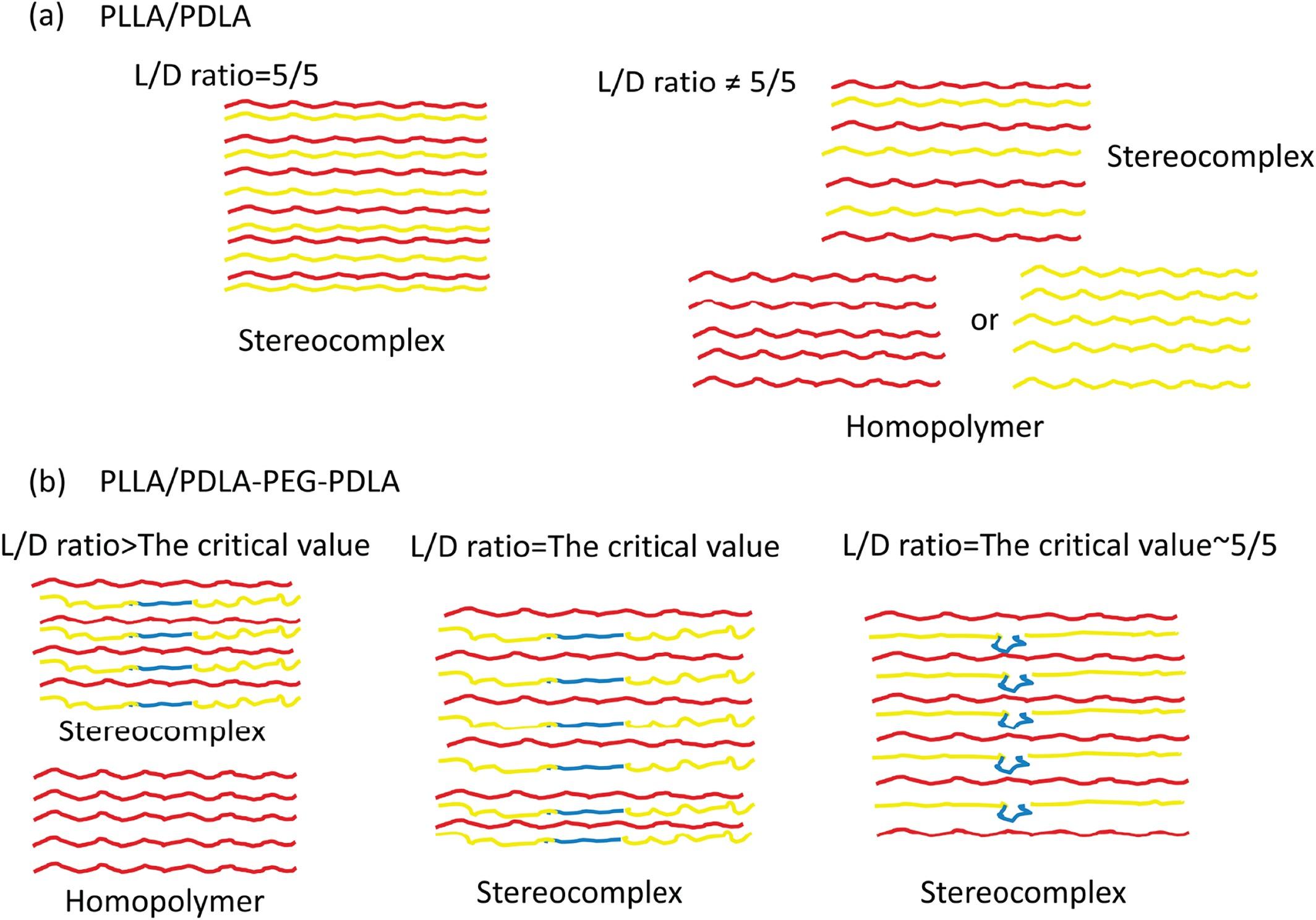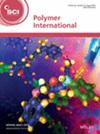下载PDF
{"title":"线性聚l -丙交酯与PDLA-PEG-PDLA三嵌段共聚物立体络合的研究","authors":"Zhanxin Jing, Xuetao Shi, Guangcheng Zhang, Ruiying Lei","doi":"10.1002/pi.4932","DOIUrl":null,"url":null,"abstract":"<p>In this study, stereocomplexed poly(lactide) (PLA) was investigated by blending linear poly(<span>l</span>-lactide) (PLLA) and tri-block copolymer poly(<span>d</span>-lactide) − (polyethylene glycol) − poly(<span>d</span>-lactide) (PDLA-PEG-PDLA). Synthesized PDLA-PEG-PDLA tri-block copolymers with different PEG and PDLA segment lengths were studied and their influences on the degree of sterecomplexation and non-isothermal crystallization behaviour of the PLLA/PDLA-PEG-PDLA blend were examined in detail by DSC, XRD and polarized optical microscopy. A full stereocomplexation between PLLA and PDLA-PEG<sub>4k</sub>-PDLA200 could be formed when the L/D ratio ranged from 7/3 to 5/5 without the presence of PLA homocrystals. The segmental mobility and length of both PEG and PDLA are the dominating factors in the critical D/L ratio to achieve full stereocomplexation and also for nucleation and spherulite growth during the non-isothermal crystallization process. For fixed PEG segmental length, the stereocomplexed PLA formed showed first an increasing and then a decreasing melting temperature with increasing PDLA segments due to their intrinsic stiff mobility. Furthermore, the effect of PEG segmental mobility on PLA stereocomplexation was investigated. The results clearly showed that the crystallization temperature and melting temperature of stereocomplexed-PLA kept increasing with increasing PEG segmental length, which was due to PEG soft mobility in the tri-block copolymers. However, PEG was not favourable for nucleation but could facilitate the spherulite growth rate. Both the PDLA and PEG segmental lengths in the tri-block copolymers affect the crystallinity of stereocomplexed-PLA and the stereocomplexation formation process; they have a different influence on blends prepared by solution casting or the melting method. © 2015 Society of Chemical Industry</p>","PeriodicalId":20404,"journal":{"name":"Polymer International","volume":"64 10","pages":"1399-1407"},"PeriodicalIF":2.9000,"publicationDate":"2015-04-29","publicationTypes":"Journal Article","fieldsOfStudy":null,"isOpenAccess":false,"openAccessPdf":"https://sci-hub-pdf.com/10.1002/pi.4932","citationCount":"21","resultStr":"{\"title\":\"Investigation of poly(lactide) stereocomplexation between linear poly(L-lactide) and PDLA-PEG-PDLA tri-block copolymer\",\"authors\":\"Zhanxin Jing, Xuetao Shi, Guangcheng Zhang, Ruiying Lei\",\"doi\":\"10.1002/pi.4932\",\"DOIUrl\":null,\"url\":null,\"abstract\":\"<p>In this study, stereocomplexed poly(lactide) (PLA) was investigated by blending linear poly(<span>l</span>-lactide) (PLLA) and tri-block copolymer poly(<span>d</span>-lactide) − (polyethylene glycol) − poly(<span>d</span>-lactide) (PDLA-PEG-PDLA). Synthesized PDLA-PEG-PDLA tri-block copolymers with different PEG and PDLA segment lengths were studied and their influences on the degree of sterecomplexation and non-isothermal crystallization behaviour of the PLLA/PDLA-PEG-PDLA blend were examined in detail by DSC, XRD and polarized optical microscopy. A full stereocomplexation between PLLA and PDLA-PEG<sub>4k</sub>-PDLA200 could be formed when the L/D ratio ranged from 7/3 to 5/5 without the presence of PLA homocrystals. The segmental mobility and length of both PEG and PDLA are the dominating factors in the critical D/L ratio to achieve full stereocomplexation and also for nucleation and spherulite growth during the non-isothermal crystallization process. For fixed PEG segmental length, the stereocomplexed PLA formed showed first an increasing and then a decreasing melting temperature with increasing PDLA segments due to their intrinsic stiff mobility. Furthermore, the effect of PEG segmental mobility on PLA stereocomplexation was investigated. The results clearly showed that the crystallization temperature and melting temperature of stereocomplexed-PLA kept increasing with increasing PEG segmental length, which was due to PEG soft mobility in the tri-block copolymers. However, PEG was not favourable for nucleation but could facilitate the spherulite growth rate. Both the PDLA and PEG segmental lengths in the tri-block copolymers affect the crystallinity of stereocomplexed-PLA and the stereocomplexation formation process; they have a different influence on blends prepared by solution casting or the melting method. © 2015 Society of Chemical Industry</p>\",\"PeriodicalId\":20404,\"journal\":{\"name\":\"Polymer International\",\"volume\":\"64 10\",\"pages\":\"1399-1407\"},\"PeriodicalIF\":2.9000,\"publicationDate\":\"2015-04-29\",\"publicationTypes\":\"Journal Article\",\"fieldsOfStudy\":null,\"isOpenAccess\":false,\"openAccessPdf\":\"https://sci-hub-pdf.com/10.1002/pi.4932\",\"citationCount\":\"21\",\"resultStr\":null,\"platform\":\"Semanticscholar\",\"paperid\":null,\"PeriodicalName\":\"Polymer International\",\"FirstCategoryId\":\"92\",\"ListUrlMain\":\"https://onlinelibrary.wiley.com/doi/10.1002/pi.4932\",\"RegionNum\":4,\"RegionCategory\":\"化学\",\"ArticlePicture\":[],\"TitleCN\":null,\"AbstractTextCN\":null,\"PMCID\":null,\"EPubDate\":\"\",\"PubModel\":\"\",\"JCR\":\"Q2\",\"JCRName\":\"POLYMER SCIENCE\",\"Score\":null,\"Total\":0}","platform":"Semanticscholar","paperid":null,"PeriodicalName":"Polymer International","FirstCategoryId":"92","ListUrlMain":"https://onlinelibrary.wiley.com/doi/10.1002/pi.4932","RegionNum":4,"RegionCategory":"化学","ArticlePicture":[],"TitleCN":null,"AbstractTextCN":null,"PMCID":null,"EPubDate":"","PubModel":"","JCR":"Q2","JCRName":"POLYMER SCIENCE","Score":null,"Total":0}
引用次数: 21
引用
批量引用


 求助内容:
求助内容: 应助结果提醒方式:
应助结果提醒方式:


